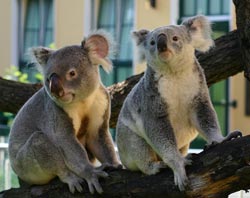Tracking koala disease: New findings from old DNA

<br>
“The process by which a retrovirus invades the host germ line appears to be quite drawn out in this case, so that the koala population has suffered the strongly pathological effects of the virus for many generations,” Roca said.
Retroviruses, of which human immunodeficiency (HIV) viruses are examples, are RNA viruses that form DNA that they then incorporate into the host’s genome. When retroviruses invade the host‘s germ line (inherited material from the eggs or sperm), the disease is transmitted to the host’s offspring.
The koala retrovirus (KoRV) is the only known retrovirus currently invading an animal germ line. Almost all koalas in northern Australia have endogenous (permanently integrated with the host) KoRV. The percentage drops drastically in populations in the south, suggesting that it is a young virus.
Roca and Greenwood hoped that studying this virus in koalas could yield new insights into how a retrovirus establishes itself in a host. They worked with an international research team that included experts from laboratories in Berlin and Copenhagen that study ancient DNA. These laboratories use specialized facilities and cutting-edge techniques to extract information from ancient and/or degraded samples that are often very small.
After extracting DNA from 28 museum koala skins dating from the late 19th century to the 1980s, the researchers were able to sequence mitochondrial DNA from 18 of the koalas. To their surprise, only three of the samples were not positive for KoRV.
“We expected that KoRV would be less widespread the farther back in time we went and that we would detect many changes in KoRV as it adapted from being an infectious virus to being part of the koala germ line,” Greenwood said.
Two of the skins that were not positive for KoRV were from southern Australia. The remaining 15 skins were all from northern Australia. This geographic distribution is surprisingly similar to that detected in modern koalas.
Another finding was that the sequences of KoRV in old and new samples were nearly the same, indicating that KoRV was already widespread 120 years ago. The results suggest that the infection first appeared much earlier than was previously thought, and was already well established in northern Australia in the late 1800s. Then it spread very slowly, possibly because koalas are sedentary.
The results suggest that KoRV has subjected koala populations to greatly increased susceptibility to disease, such as Chlamydia infection or leukemia, for over a century. In fact, there are historical reports of diseases with symptoms that might have been due to Chlamydia that swept away millions of koalas in 1887-1889.
These findings have just been published online in Molecular Biology and Evolution.
News Writer
Susan Jongeneel, 217-333-3291
News Source
Alfred Roca, 217-244-8853
Media Contact
More Information:
http://www.illinois.eduAll latest news from the category: Life Sciences and Chemistry
Articles and reports from the Life Sciences and chemistry area deal with applied and basic research into modern biology, chemistry and human medicine.
Valuable information can be found on a range of life sciences fields including bacteriology, biochemistry, bionics, bioinformatics, biophysics, biotechnology, genetics, geobotany, human biology, marine biology, microbiology, molecular biology, cellular biology, zoology, bioinorganic chemistry, microchemistry and environmental chemistry.
Newest articles

Properties of new materials for microchips
… can now be measured well. Reseachers of Delft University of Technology demonstrated measuring performance properties of ultrathin silicon membranes. Making ever smaller and more powerful chips requires new ultrathin…

Floating solar’s potential
… to support sustainable development by addressing climate, water, and energy goals holistically. A new study published this week in Nature Energy raises the potential for floating solar photovoltaics (FPV)…

Skyrmions move at record speeds
… a step towards the computing of the future. An international research team led by scientists from the CNRS1 has discovered that the magnetic nanobubbles2 known as skyrmions can be…





















